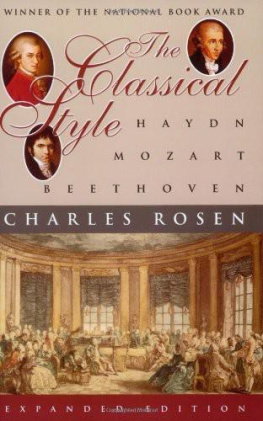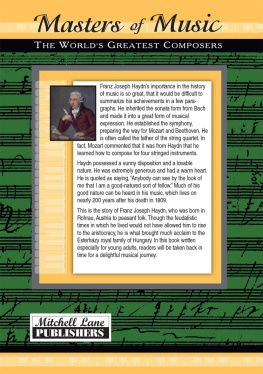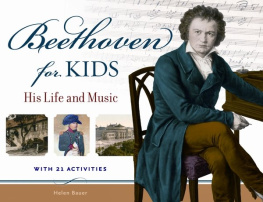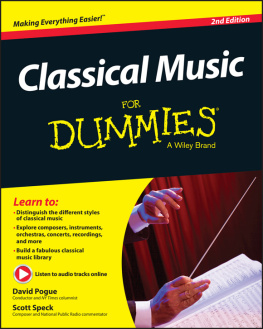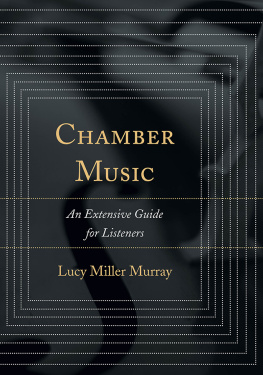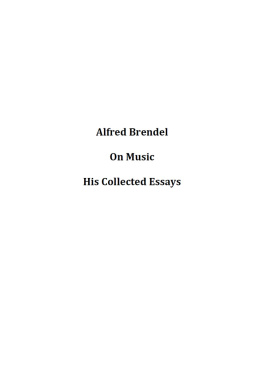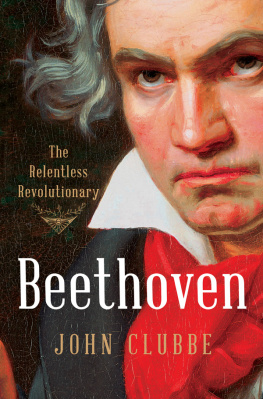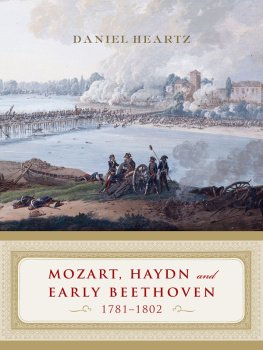The Classical Style
BY CHARLES ROSEN
The Classical Style
Haydn, Mozart, Beethoven
Arnold Schoenberg
Sonata Forms
The Musical Languages of Elliott Carter
Plaisir de Jouer, plaisir de penser
Conversation avec Catherine Temerson
The Frontiers of Meaning
Three Informal Lectures on Music
The Romantic Generation
BY CHARLES ROSEN AND HENRI ZERNER
Romanticism and Realism
The Mythology of Nineteenth-Century Art

The Classical Style
Haydn, Mozart, Beethoven
EXPANDED EDITION
Charles Rosen
W.W. Norton & Company
New York London
For Helen and Elliott Carter
[Zangler: Why do you keep repeating that idiotic word "classic"?
Melchior: Oh, the word isn't idiotic, it's just often used idiotically.]
Contents
I INTRODUCTION
Period style and group style, 20; Tonality, 23; Tonic-dominant polarity, 25; Modulation, 26; Equal temperament, 27; Weakening of linear form, 28.
Nineteenth-century conception of sonata form, 30; Twentieth-century revisions, 32; Schenker, 33; Motivic analysis, 36; Vulgar errors, 40.
Dramatic character of the classical style, 43; Range of styles 1755-1775, 44; Public and private music, 45; Mannerist period, 47; Proto-classical symmetries and patterns, 49; Determinants of form, 51.
II THE CLASSICAL STYLE
1. THE COHERENCE OF THE MUSICAL LANGUAGE 57
Periodic phrase, 57; Symmetry and rhythmic transition, 58; Homogeneous (Baroque) vs. heterogeneous (classical) rhythmic systems, 60; Dynamics and ornamentation, 62; Rhythmic and dynamic transition (Haydn Quartet op. 33 no. 3), 64; Harmonic transition (modulation), 68; Decorative vs.
dramatic styles, 70; Conventional material, 71; Tonal stability and resolution, 72; Recapitulation and articulation of tension, 74; Reinterpretation and secondary tonalities, 78; Subdominants, 79; Contrast of themes, 80; Reconciliation of contrasts, symmetrical resolution, 82; Relation of large form to phrase, expansion technique (Haydn Piano Trio, H.19, 83); Correspondence of note, chord, and modulation, 89; Articulation of rhythm, weight of individual beat, 90; Sonata style and eccentric material: fantasy form (Mozart, Fantasy K. 475), 91; Audible vs. inaudible form, 93; Extra-musical influence, 94; Wit in music, 95.
2. STRUCTURE AND ORNAMENT 99
Sonata forms generalized, 99; Structure vs. ornament, 100; Ornamentation in the late eighteenth century, 101; Radical change in function of decoration.
ILL H A Y D N FROM 1770 TO THE D E A T H OF MOZART
1. STRING QUARTET 111
Haydn and Carl Philipp Emanuel Bach, i n ; Beginning in a false key, 112; Innovations of the Scherzi quartets, thematic accompaniment, 115; Energy latent in musical material, 120; Dissonance as principal source of energy, 120; Directional power of material, 129; Sequence as source of energy, 134; Reinterpretation by transposition, 135; Relation of string quartet to classical tonal system, 137; Further development of Haydn's string quartets, 138; String quartet and the art of conversation, 141.
2. SYMPHONY
Development of the orchestra and symphonic' style, 143; stylistic progress, 146; Sturm und Drang style, 147; Symphony no. 46, 147; Weakness of rhythmic organization of early Haydn, 149; Symphony no. 47, 151; Influence of opera, 153; Symphony no. 75, 155; New clarity and sobriety, 157; Symphony no. 81, 157; Wit and symphonic grandeur, 159; Oxford Symphony, 159; Haydn and pastoral, 162.
IV SERIOUS OPERA
Problematic status of opera seria, 166; Conventions of opera seria and buffa, 167; Eighteenth-century tragedy, 168; High Baroque style, 169; Dramatic and elegiac modes, 170; Gluck, 170; Neo-classical doctrine, 171; Music and the aesthetic of expression, 173; Words and music, 173; Gluck and rhythm, 174; Mozart and Idomeneo, 177; Recitative and complex forms, 178; Fusion of seria and buffa, Marriage of Figaro, 181; Fidelio, 183.
V MOZART
1. THE CONCERTO
Mozart and dramatic form, 185; Tonal stability, 186; Symmetry and the flow of time, 187; Continuo playing in the late eighteenth century, 191; Musical significance of the continuo, 194; Concerto as drama, 196; Opening ritornello, 197; Concerto in E flat K.271, 198; Piano exposition as dramatization of orchestral exposition, 205; Symmetry of climax, 207; Secondary development within recapitulation, 211; Slow movement of K.271
as expansion of opening phrase, 211; Mirror symmetry, 212; Concerto finale, 213; Sinfonia Concertante K. 364, 214; Thematic relationships, 215; K.412, K.413, K.4'15, 218; K.449, 219; K.456, modulating second theme, 221; Dramatic range of slow movement, 223; Variation-finales, 225; K.
459 and fugal finales, 226; K. 466, art of rhythmic acceleration, 227; Thematic unity, 233; K. 467 and symphonic style, 235; Slow movement, improvisation, and symmetry, 238; K. 482, orchestral color, 240; K.488, articulation of close of exposition, 241; Slow movement and melodic structure, 243; K.503, technique of repetition, 251; Major and minor, 254; Sense of mass, 256; K. 537, proto-Romantic style and loose melodic structure, 258; Clarinet Concerto, continuity of overlapping phrases, 260; K. 595, resolution of chromatic dissonance, 263.
2. STRING QUINTET 264
Concertante style, 264; K.174, expanded sonority and expanded form, 265; K.515, irregular proportions, 267; Expansion of form, 273; K.516, problem of classical finale, 274; Major ending to a work in the minor, 276; Expressive limits of the style, 277; Place of minuet in the order of movements, 280; Virtuosity and chamber music, 281; K.593, 281; Slow introductions, 282; Harmonic structure and sequences, 283; K. 614, influence of Haydn, 286.
3. COMIC OPERA 288
Music and spoken dialogue, 288; Classical style and action, 289; Ensembles, sextet from The Marriage of Figaro, and sonata form, 290; Sextet from Don Giovanni and sonata proportions, 296; Tonal relations in opera, 298; Recapitulation and dramatic exigency, 301; Operatic finales, 302; Arias, 306; 'Se vuol ballare' from The Marriage of Figaro, 308; Coincidence of musical and dramatic events: graveyard scene from DonGiovanni, 309; Comedy of intrigue, 312; Eighteenth-century concept of personality, 313; Comedy of experimental psychology and Marivaux, Cos1
fan tutte, 314; Virtuosity of tone, 316; Die Zauberflote, Carlo Gozzi and the dramatic fable, 317; Music and moral truth, 319; Don Giovanni and the mixed genre, 321; Scandal and politics, 322; Mozart as subversive, 324.
VI H A Y D N AFTER T H E D E A T H OF MOZART
1. THE POPULAR STYLE 329
Haydn and folk music, 329; Fusion of high art and popular style, 332; Integration of popular elements, 333; Surprise return of theme in finales, 337; Minuets and popular style, 340; Orchestration, 342; Introduction as dramatic gesture, 345.
2. PIANO TRIO 351
Reactionary form, 351; Chamber music and pianistic virtuosity, 352; Instruments in Haydn's day, 353; Doubling of bass line by cello, 354; H.14, 355; H.22 and expansion of the phrase, 356; H.28, Haydn's early style transformed, 359; H.26, acceleration of motivic elements within a phrase, 361; H.31, luxuriant variation technique, 362; H.30, Haydn's chromaticism, 363.
3. CHURCH MUSIC 366
Expressive vs. celebrative aesthetic, 366; Opera buffa style and religious music, 367; Mozart's parodies of Baroque style, 367; Haydn and religious music, 368; Oratorios and pastoral style, 370; 'Chaos' and sonata form, 370; Beethoven's Mass in C Major, problems of pacing, 373; ) Major Mass, 375.
Next page
